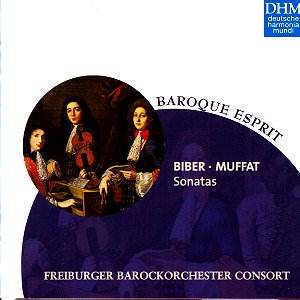Both Muffatt and Biber were attracted to the service
of the ruling Archbishop of Salzburg in the late 17th Century.
Archbishop Max Gandolph was a generous patron and they both dedicated
many of their compositions to him. Both were very fond of the sonata
as an instrumental form and those on this recording were drawn from
publications dedicated to the Archbishop.
During the Baroque era there was a gradual move away
from the trio sonata (sonatas in 3 or more parts) towards the sonata
for one solo instrument with continuo accompaniment. However during
the whole of this period the string sonata with basso continuo remained
popular. However there was a gradual blurring of the distinction between
church sonatas (sonata da chiesa, with their alternation of slow and
fast movements) and secular sonatas (sonata da camera, which often consisted
of a sequence of dance movements).
Biber's sonatas in his "Sonatae tam Aris, quam Aulis
servientes" (Sonatas intended for both use at the altar and at court)
display just such a blurring. And it is from this publication that the
Sonatas by Biber on this disc are taken. Written in 1670 before he left
for Salzburg, it was published in 1676 in Salzburg. There are no actual
dance movements are quoted by name - in fact the sonatas are not split
up into movements at all. Each sonata consists of a continuous sequence
of short sections, each having its own characteristics. The frequent
tempo and metrical changes make the dance origins clear.
The two Muffatt sonatas are much longer. Muffatt's
five-part sonata cycle "Armonico tributo" (Harmonic tribute) was dedicated
to the Archbishop on the occasion of the 1100th anniversary
of the foundation of the Archbishopric of Salzburg. The dedication includes
thanks to the Archbishop for letting Muffatt go to Italy to study concerto
grosso technique with Corelli and the sonatas in this publication are
all based on the concerto grosso. In fact "Armonico tributo" was composed
whilst Muffatt was still in Italy. These sonatas in the form of a concerto
grosso were actually called symphonies by Muffatt - a reminder of how
flexible these terms were in the late 17th century. But the
parts are clearly marked with solo and tutti sections and Muffatt re-worked
the sonatas and published them as concerti grossi in 1701.
This is wonderful music and the Freiburger Barockorchester
Consort play it with a rhythmic vitality and elasticity that is at times
toe-tappingly infectious. Their performances of the Biber sonatas have
a verve and energy and combined with an admirable rhythmic flexibility,
so that each of the varied short sections moves naturally into the next.
Part of their secret is to give each little section its full due, irrespective
of length. This makes for a lively but coherent performance of each
sonata. And in the slower sections they are able to thin their tone
down to a wonderful transparency. The Muffatt sonatas are rather more
robust but here also, the group shines.
The group makes a lean sound, but this matches their
lively and lithe approach to the music, though one could also imagine
a different, rather more well upholstered approach. (And I did have
a slightly guilty wish that the group could have employed more of a
shading of vibrato on some of the exposed longer notes.) On a technical
level the group are never in doubt, throwing off the more florid, virtuoso
passages with admirable ease without making too much of a feature of
it. Technique is always put at the service of the music.
This record is a must for all lovers of this music.
Sensibly, the Freiburger Barockorchester Consort do not give us all
the Biber sonatas, mixing them with the 2 Muffatt ones. Some purists
might prefer a disc which includes all the Biber sonatas, but with such
lovely performances here I just hope that we get the rest of the sonatas
on another disk.
Robert Hugill
